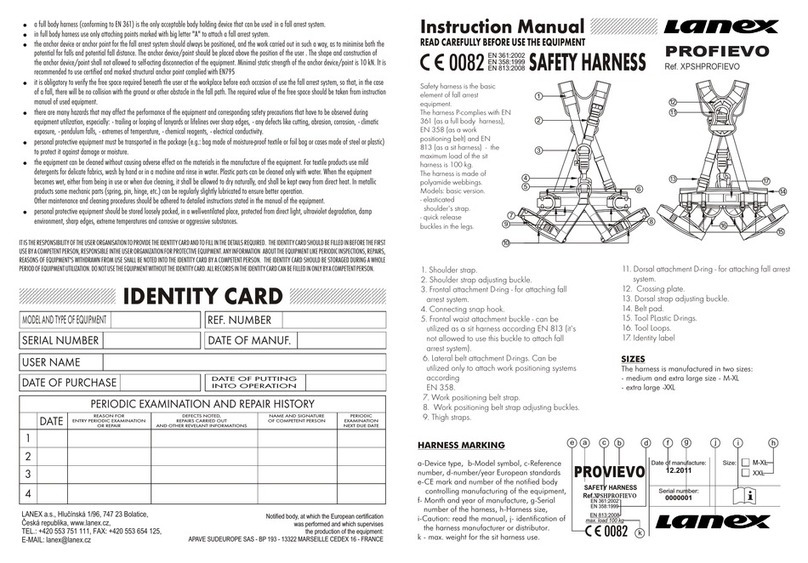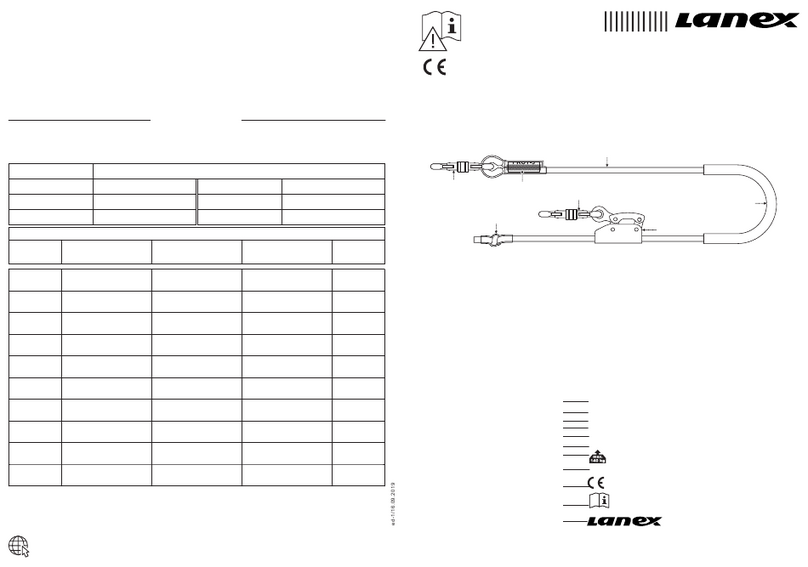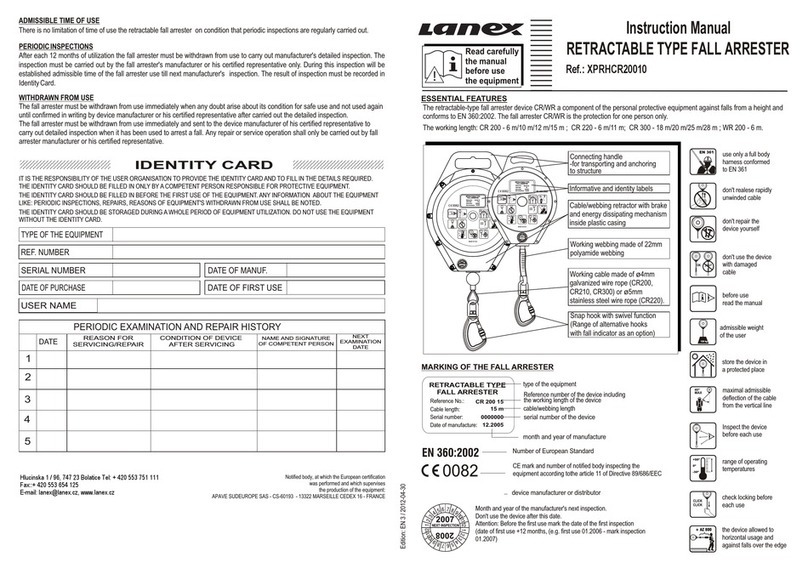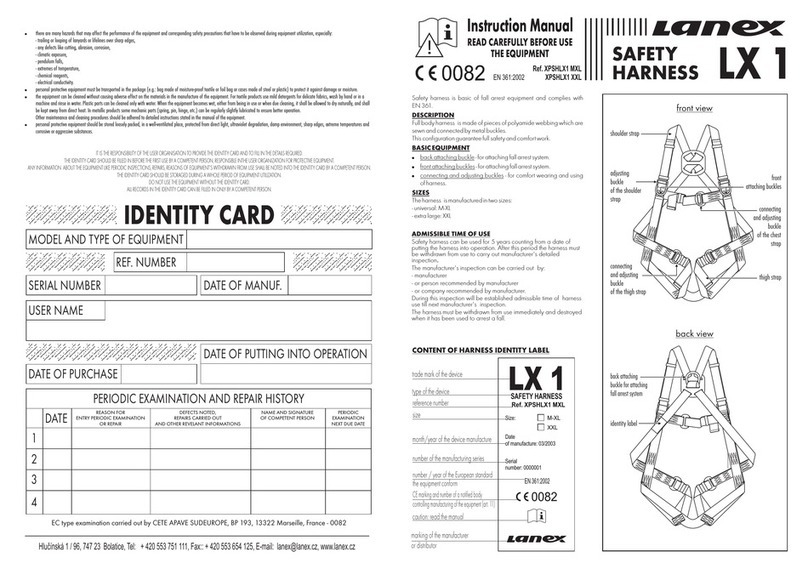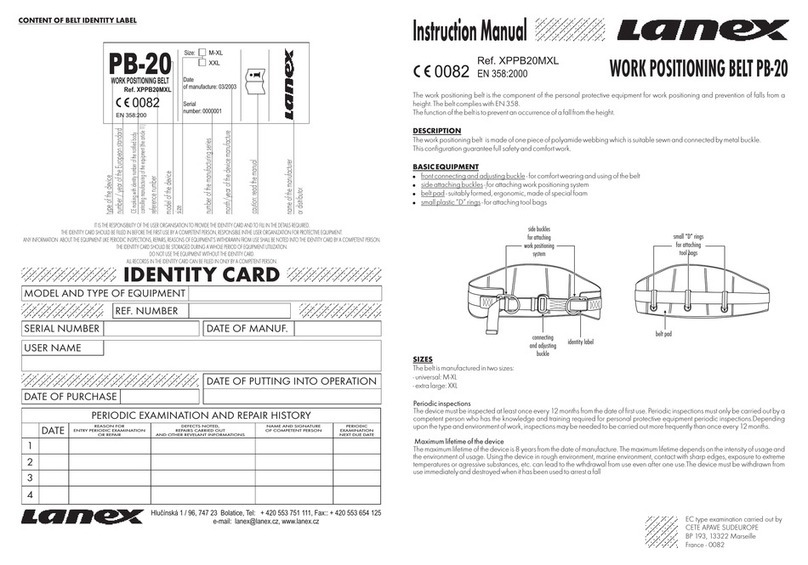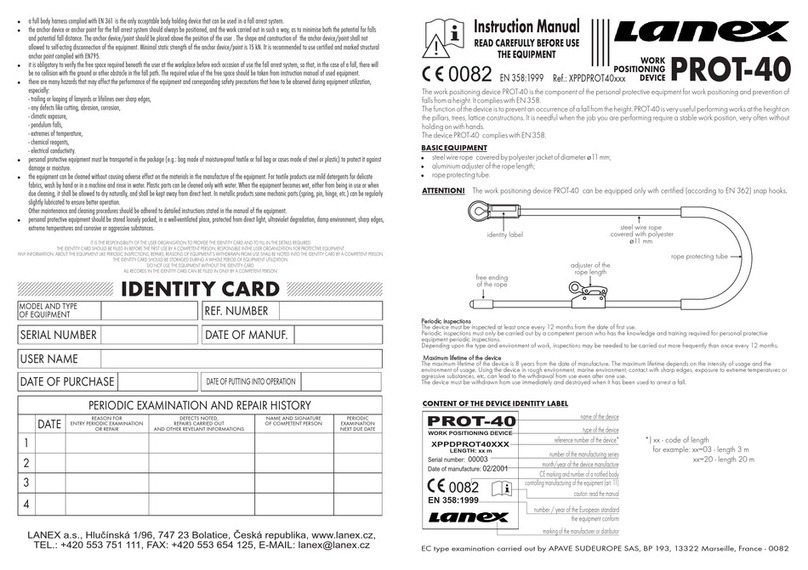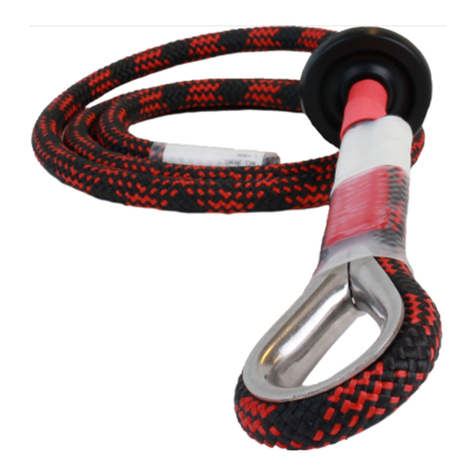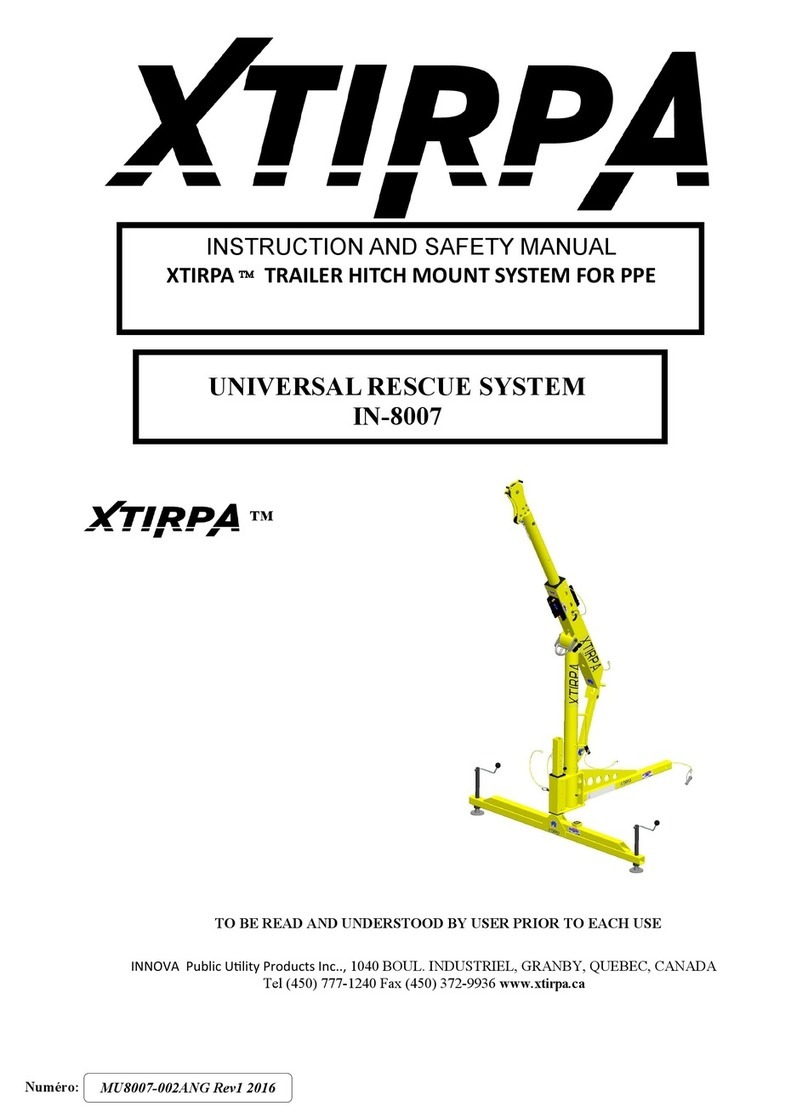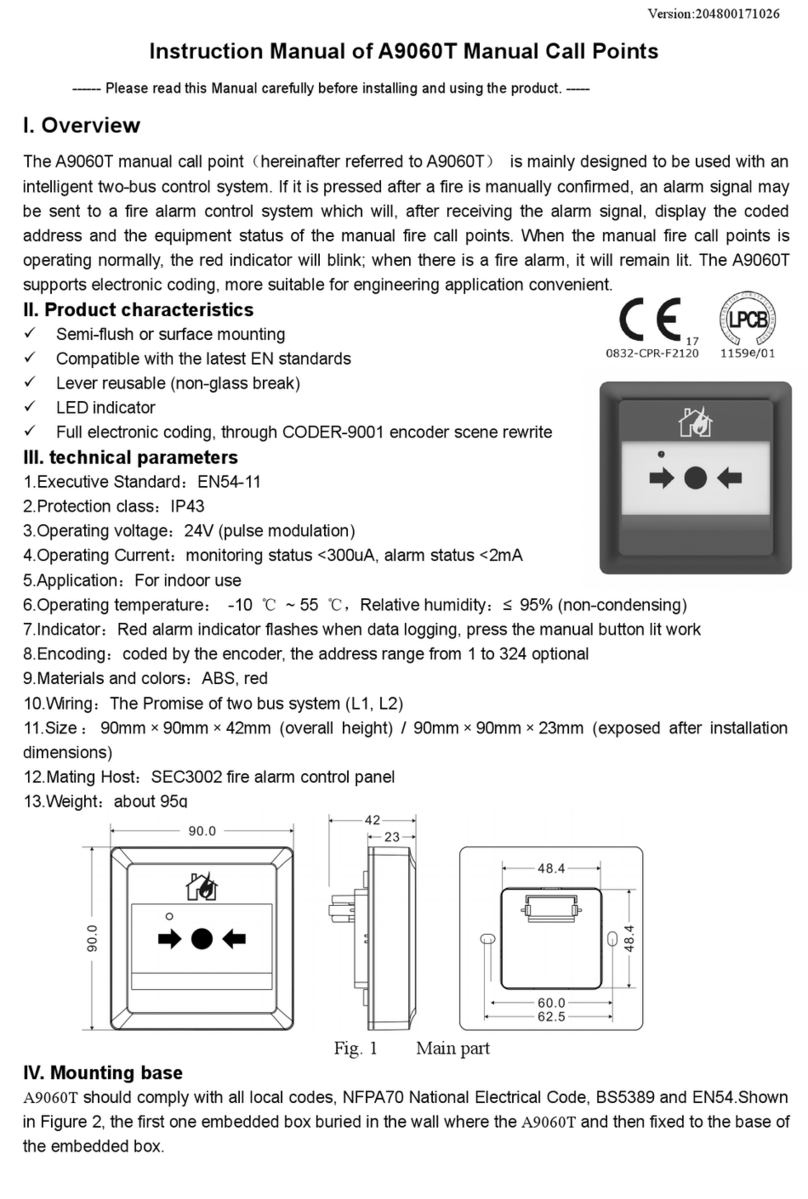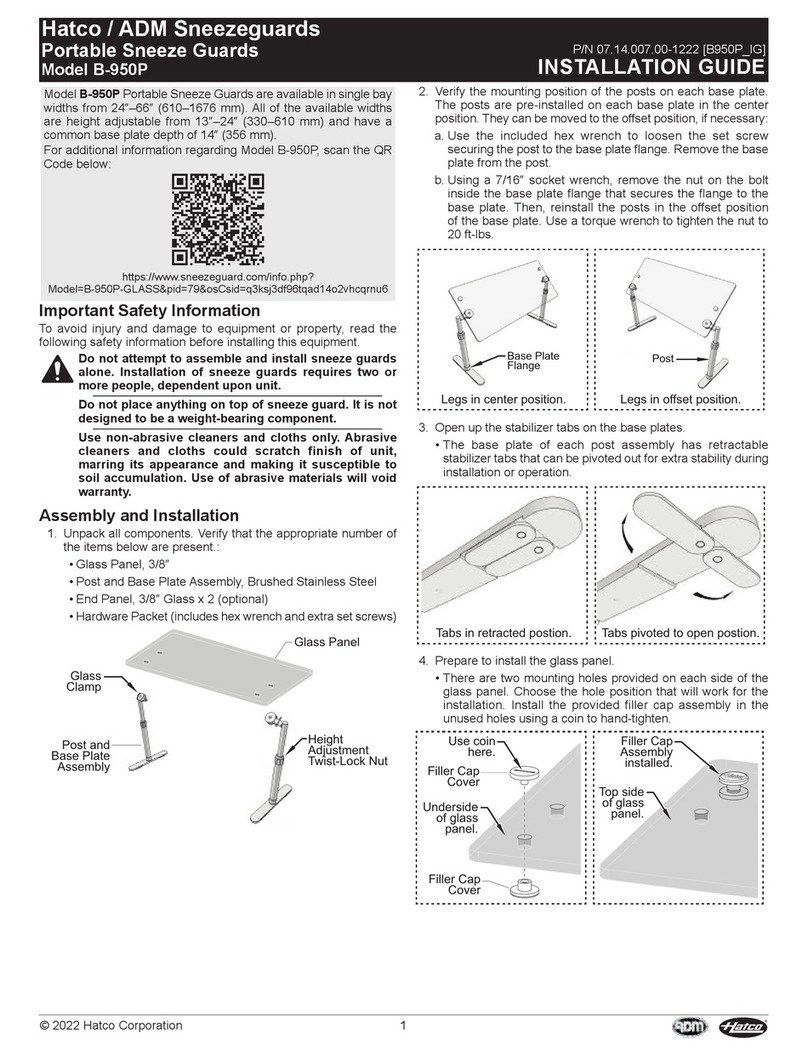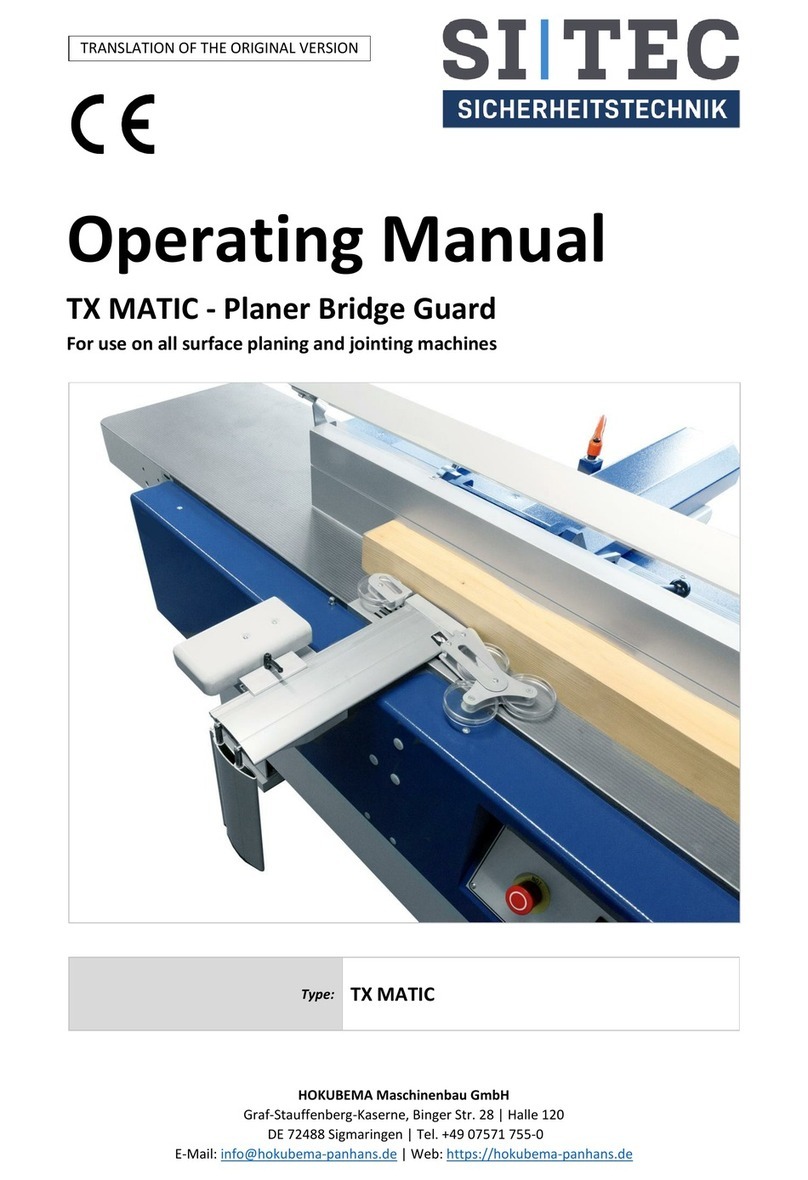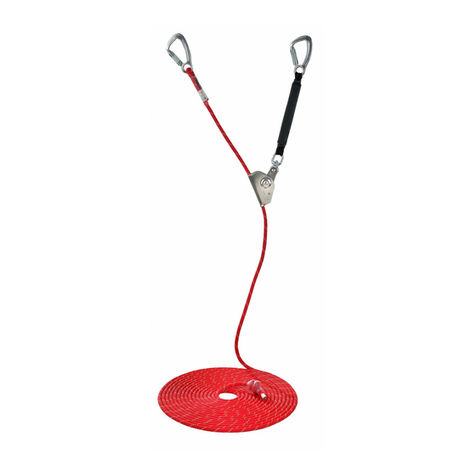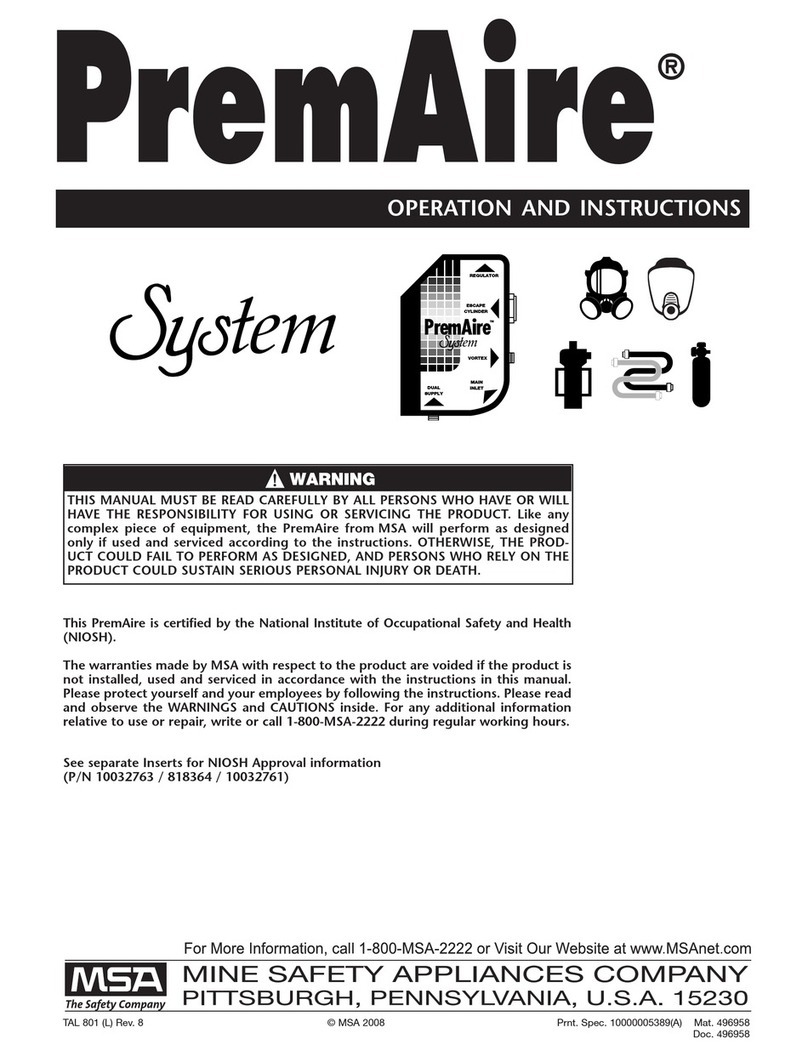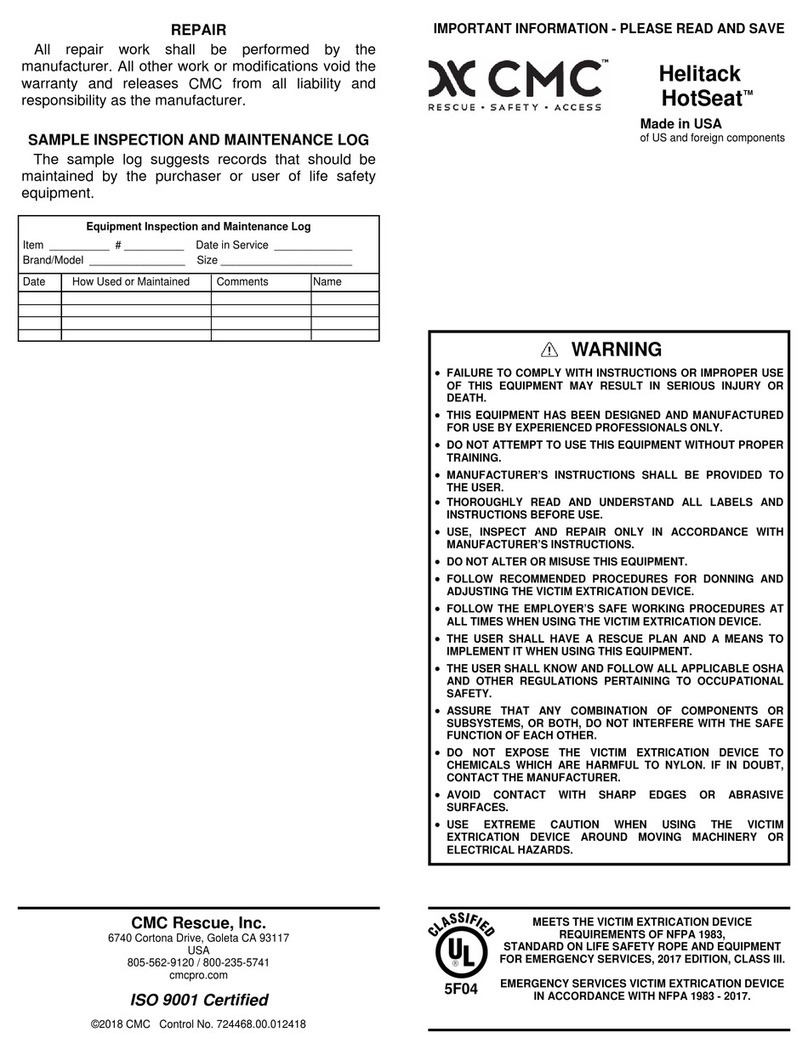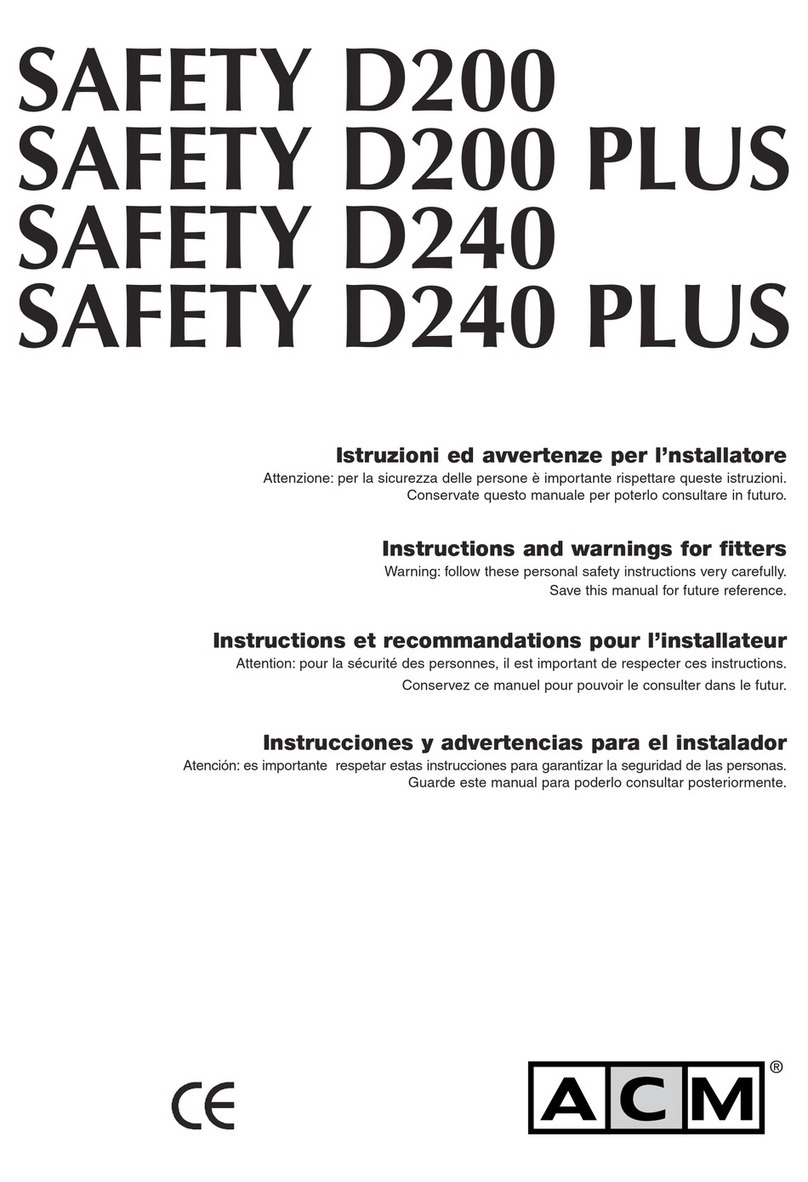
GB - NOTICE: Read and fully understand these instructions before using this equipment.
DESCRIPTION
Safety harness is a body holding device which is a component of personal protective
equipment described in EN 363 standard intended to protect the user against falls from a
height. The harness is approved for a user, including tools and equipment, with a weight of
up to 140 kg. Maximum rated load 140 kg for EN361 full body harness is permited only
when energy absorbing elelent compatible with 140 kg maximum rated load is used.
Energy absorbing element must be tested according to Rfu 11.062 or revelant EN
standard.
Basic materials:
- webbings - aramid/polyester
- connecting/adjustment buckles: steel
- attachment D-rings:
NOMENCLATURE
Shoulder strap.
2 Leg strap.
3 Leg strap connecting/adjustment buckle.
4 Chest strap.
5 Chest strap connecting/adjustment buckle.
6 Identity label.
7 Fall arrest (A) back attachment D-ring EN361.
8 Fall arrest (A) frontal attachment loops EN 361.
9 Shoulder strap adjustment buckle.
10. Fall arrest (A) extension strap EN361.
11.
12.
13.
14.
15. Tool loops -
16. Buckle cover.
SIZES
The harness is manufactured in four sizes:
- small: S
- universal: M-XL
- extra-large: XXL
- extra, extra-large: XXXL
D. DONNING THE HARNESS:
E. CONNECTING THE BUCKLES
F. ADJUSTING THE STRAPS
F.1 Tightening
F.2 Loosening
G MEANING OF THE MARKING
Model symbol;
Device type;
Reference number;
Harness size;
Month and year of manufacture;
Serial number of the harness;
number/year of European standards;
h CE mark and number of the notified body controlling manufacturing of the equipment;
i Caution: read and understand the instruction manual before use;
j) Waist belt size in cm;
k identification of the harness manufacturer or distributor
H. ATTACHING THE HARNESS
H 1 ATTACHING FALLARRESTS SYSTEMS – EN361
Fall arrest system can be attached only to the fall arrest attachment point of full body harness EN 361
marked with capital letter A:
- directly to the back D-ring (H.1.1)
- to extension strap (H.1.2).
- to the front attachment loops. The loops marked with a half of letter must be linked together when
attached to the fall arrest system (H.1.3). It is strictly forbidden to attach a fall arrest system to a single
loop with a half of letter A (H.1.4).
A.
B.
1.
.
.
.
.
.
.
.
.
Lateral belt work positioning D-rings EN 358.
Work positioning belt waist strap.
Work positioning belt adjustment buckle.
Belt pad.
to be used with hand tools of max. weight 2 kg.
C.
.
a)
b)
c)
d)
e)
f)
g)
)
)
)
.
The harness is certified and complying with the standard:
EN 361:2002 as a full body harness intended to be used in fall arrest systems.
:2018 as the .
steel
- webbings - polyester, polyamide (shoulder straps)
- connecting/adjustment buckles: steel
- attachment D-rings: steel
- webbings - polyester, polyamide (shoulder straps)
- connecting/adjustment buckles: steel
- attachment D-rings: steel covered with polypropylene
- connecting/adjustment sheath - PVC
D
D
D
D
D
D
D
D
The length of the extension strap must be taken into cosideration when
required free clearance below working platform is calculating.
!
!EN 358 work positioning belt to be used with work positioning equipment
.1 Hold the harness by dorsal D-ring. Shake the harness to allow all straps to fall in place.
.2 Put on the shoulder straps one after one, take care do not twist them.
.3 Connect and tighten the chest strap.
.4 Connect and tighten the leg straps. The straps should fit tight around the legs.
.5 Connect and tighten the waist strap. The strap should fit tight around the waist.
.6 Adjust the shoulder straps so the harness fits the body, not too tight. Free ends of the straps
must be kept by the plastic keepers.
.7 Back attachment D-ring must be positioned between shoulder blades.
.8 Front attachment D-ring or attachment linked loops must be centred on lower chest.
P-50NS, P-50NX:
P-51EX, P-51EX/LT401, P-61E:
P-51EX ISOL:
H.2.
Work positioning or restraint system should be attached to the work positioning belt EN 358 D-rings.
Work positioning lanyard can be connected to to a structure by encircling it (H2.1) or directly to an
anchor point (H2.2). Work positioning system must be connected to a structure or an anchor point that
is positioned at waist level or above
there is a foreseeable risk of the user becoming suspended or being exposed to
unintended tension by the waist belt. When using a work positioning system, the user normally relies
on the equipment for support, therefore it is essential to consider the need of using a back-up, e.g. a
fall arrest system.
I. PERIODIC INSPECTIONS
Safety harness must be inspected at least once every 12 months from the date of first use. Periodic
inspections must be carried out by a competent person who has the knowledge and training
required for personal protective equipment periodic inspections. Depending upon the type and
environment of work, inspections may be needed to be carried out more frequently than once every 12
months.
CONNECTING WORK POSITIONING SYSTEMS – EN358
. Work positioning lanyard must be kept taut during use. It is strictly
forbidden to use the work positioning belt EN358 D-rings or loops for fall arrest puroposes. The belt
shouldn’t be used if
only
J MAXIMUM LIFESPAN OF THE EQUIPMENT
The maximum lifespan of the harness is 10 years from the date of manufacture.
ATTENTION: The harness maximum lifetime depends on the intensity of usage and the environment of
usage. Using the harness in rough environment, marine environment, contact with sharp edges,
exposure to extreme temperatures or aggressive substances, etc. can lead to the withdrawal from use
even after one use.
K. WITHDRAWAL FROM USE
The harness must be withdrawn from use immediately and destroyed when it has been used to arrest a
fall or it fails to pass inspection or there are any doubt as to its reliability.
L THE ESSENTIAL PRINCIPLES FOR USERS OF PERSONAL PROTECTIVE EQUIPMENT
AGAINST FALLS FROM A HEIGHT:
personal protective equipment shall only be used by a person trained and competent in its safe
use.
personal protective equipment must not be used by a person with medical condition that could
affect the safety of the equipment user in normal and emergency use.
a rescue plan shall be in place to deal with any emergencies that could arise during the work.
being suspended in PPE (e.g. arresting a fall), beware of suspension trauma symptoms.
to avoid symptoms of suspension trauma, be sure that the proper rescue plan is ready for use. It
is recommended to use foot straps.
it is forbidden to make any alterations or additions to the equipment without the manufacturer's
prior written consent.
any repair shall only be carried out by equipment manufacturer or his certified representative.
personal protective equipment shall not be used outside its limitations, or for any purpose other
than that for which it is intended.
personal protective equipment should be a personal issue item.
before use ensure about the compatibility of items of equipment assembled into a fall arrest
system. Regularly check connecting and adjusting of the equipment components during use to avoid
accidental loosening or disconnecting of the components.
it is forbidden to use combinations of items of equipment in which the safe function of any one
item is affected by or interferes with the safe function of another.
before each use of personal protective equipment it is obligatory to carry out a pre-use check of
the equipment, to ensure that it is in a serviceable condition and operates correctly before it is used.
during pre-use check it is necessary to inspect all elements of the equipment in respect of any
damages, excessive wear, corrosion, abrasion, cutting or incorrect acting, especially take into
consideration:
in full body harnesses and belts - buckles, adjusting elements, attaching points, webbings,
seams, loops;
in energy absorbers - attaching loops, webbing, seams, casing, connectors;
in textile lanyards or lifelines or guidelines - rope, loops, thimbles, connectors, adjusting element,
splices;
in steel lanyards or lifelines or guidelines - cable, wires, clips, ferrules, loops, thimbles,
connectors, adjusting elements;
in retractable fall arresters - cable or webbing, retractor and brake proper acting, casing, energy
absorber, connector;
in guided type fall arresters - body of the fall arrester, sliding function, locking gear acting, rivets
and screws, connector, energy absorber;
in metalic components (connectors, hooks, anchors) - main body, rivets, gate,
locking gear acting.
after every 12 months of utilization, personal protective equipment must be withdrawn from use
to carry out periodical detailed inspection. The periodic inspection must be carried out by a competent
person for periodic inspection. The periodic inspection can be carried out also by the manufacturer or
his authorized representative.
in case of some types of the complex equipment e.g. some types of retractable fall arresters the
annual inspection can be carried out only by the manufacturer or his authorized representative.
regular periodic inspections are the essential for equipment maintenance and the safety of the
users which depends upon the continued efficiency and durability of the equipment.
during periodic inspection it is necessary to check the legibility of the equipment marking. Don’t
use the equipment with the illegible marking.
it is essential for the safety of the user that if the product is re-sold outside the original country of
destination the reseller shall provide instructions for use, for maintenance, for periodic examination and
for repair in language of the country in which the product is to be used.
personal protective equipment must be withdrawn from use immediately when any doubt arise
about its condition for safe use and not used again until confirmed in writing by equipment
manufacturer or his representative after carried out the detailed inspection.
personal protective equipment must be withdrawn from use immediately and destroyed (or
another procedures shall be introduced according detailed instruction from equipment manual) when it
have been used to arrest a fall.
a full body harness (conforming to EN 361) is the only acceptable body holding device that can
be used, in a fall arrest system.
in full body harness use only attachment points marked with a capital letter "A" to attach a fall
arrest system.
the anchor device or anchor point for the fall arrest system should always be positioned, and the
work carried out in such a way, as to minimise both the potential for falls and potential fall distance. The
anchor device/point should be placed above the position of the user . The shape and construction of
the anchor device/point shall not allowed to self-acting disconnection of the equipment. Minimal static
strength of the anchor device/point is 12 kN. It is recommended to use certified and marked structural
anchor point complied with EN795
.
.
-
-
-
-
-
-
-
!
!
!
!
!
!
!
!
!
!
!
!
!
!
!
!
!
!
!
!
!
!
!
Every periodic inspection must be recorded in the Identity Card of the equipment.
